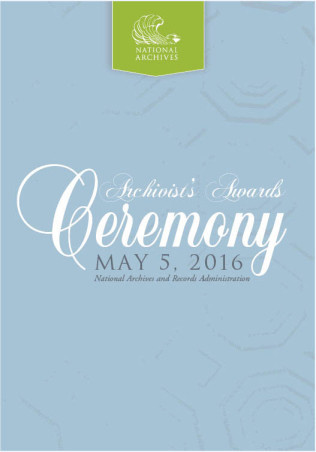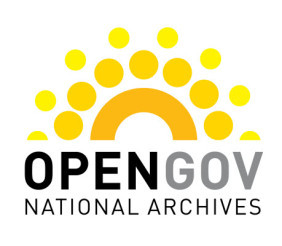David S. Ferriero's Blog, page 20
May 6, 2016
Celebrating Service to the Public
Yesterday, at our annual Archivist’s Achievement Awards ceremony, we celebrated Public Service Recognition Week by recognizing staff across the country for their exceptional contributions to the mission of the agency.
In my remarks, I said:
As you have heard me say before: for me every week of the year is Public Service Recognition Week because I am so proud of the work that you all do across our agency in service to the American people. Whether you are redacting pages from a service record in St. Louis, or refiling an IRS return in Lenexa, or helping someone navigate the FOIA process, or connecting someone with their family history, or ensuring that our staff and users are safe, or restoring a deteriorating film, or ensuring the a First Lady’s correspondence is accounted for, or educating a school group about how our government works, or safeguarding NARA holding from leaks, condensation, and frost problems, or doing any one of the hundreds of tasks the comprise the work of the National Archives—thank you for your passion and commitment to our mission.
Since 1985, the first week of May has been set aside to honor the men and women who serve our nation as Federal, state, county, and local government employees. In this year’s proclamation, President Obama writes:
“Our Nation’s progress has long been fueled by the efforts of selfless citizens who come together in the service of their fellow Americans to change our country for the better. At the birth of our Nation, our Founders fought to secure a democracy that represents the people, and the civil servants who pour everything they have into making a difference are the individuals who keep that democracy running smoothly and effectively. During Public Service Recognition Week, we honor those who dedicate themselves to ensuring America’s promise rings true in every corner of our country, and we recommit to upholding the values they fight for every day.”
“Throughout this week, we recognize the tireless efforts of the women and men who strive to make ours a government that stays true to its founding ideals. With 85 percent of the Federal Government jobs located outside the Washington, DC area, our Federal workers…play key roles in ensuring the voices of the American people are heard. And even in the toughest of circumstances, including a politics that does not always fully recognize the value of their work, our public servants—often at great personal sacrifice—continue striving to build a better country and to bring lasting change to the lives of ordinary people across America.”
“Serving the public is not just a paycheck—it’s contributing to the steady effort to perfect our Union over time so our democracy works for everyone. This week, let us embrace the hopeful spirit that embodies the extraordinary work of our civil servants. It is the same spirit that built America, and because of the hard work of compassionate and determine public servants, it will continue to build us up for generations to come.”
More than 50 nominations were submitted for this year’s awards. 144 NARA staff were recognized for their individual or group accomplishments ranging from improving employee engagement to volunteer service to citizen archivist to information technology quality assurance to reduction of declassification backlogs to customer service to a Presidential Library digital pilot project to helping a record number of researchers to safeguarding records at risk to creating a training program for archives technicians eligible for promotion, for example. The ceremony was broadcast to our sites across the country and staff enthusiastically celebrated the accomplishments of their colleagues—a true One NARA event! I am so proud of this staff.

April 21, 2016
FOIA Federal Advisory Committee Report
I am pleased to announce that the inaugural Freedom of Information Act (FOIA) Advisory Committee, under the direction of the Office of Government Information Services (OGIS), submitted a final report and recommendations regarding FOIA Fees, Proactive Disclosure, and Oversight and Accountability.
The Committee’s report and their recommendations is the product of two years of hard work by the Committee to study the current FOIA landscape across the Executive Branch, to provide advice on improving FOIA administration, and to make recommendations to the Archivist of the United States.
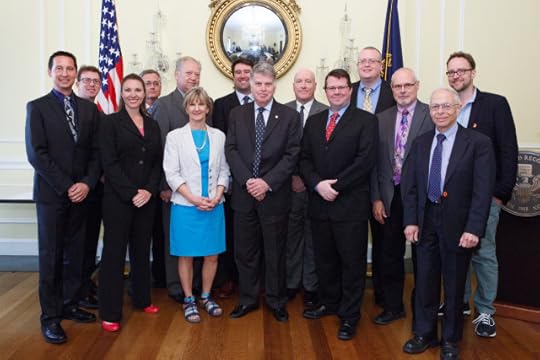
Members of the 2014-2016 Freedom of Information Act (FOIA) Advisory Committee.
From left to right: James Holzer, Mark Zaid, Ginger McCall (forner member), Brent Evitt, Larry Gottesman, Melanie Pustay, Nate Jones, David Ferriero, Lee White, Sean Moulton, Marty Michalosky, Jim Hogan, David Pritzker, Clay Johnston.
OGIS provides leadership, administrative and logistical support for the FOIA Advisory Committee. Director James Holzer serves as the Committee’s Chair, and a member of the OGIS staff acts as the Committee’s Designated Federal Officer (DFO).
Much of the Committee’s work was done by its three subcommittees: FOIA Fees, Oversight and Accountability, and Proactive Disclosures. The DFO attended all of the subcommittees’ meetings and was included on all correspondence between members. OGIS staff also ushered the Fees and Oversight and Accountability Subcommittees through the process necessary to gather new information from agency FOIA professionals about how fees are used and the role of FOIA Public Liaisons. This information improved Committee members’ and public understanding of the issues, and influenced its recommendations.
The Committee prepared this report prior to the final meeting of the 2014 – 2016 term of the Committee, and documents all of the work done by the Committee over its two year term. The report also includes background on the Committee’s creation, summaries of the Committee’s quarterly meetings, and a summary of the work undertaken by the Fees, Oversight and Accountability, and Proactive Disclosures Subcommittees. Far from an end result, Director Holzer intends to use the report as a starting point for the next term of the Committee. The Committee is accepting comments on the recommendation and on the Committee’s Final Report. Please direct all comments to: foia-advisory-committee@nara.gov
The Committee’s development of a consensus recommendation is an important milestone: it shows that agencies and requesters can work together to improve the FOIA process. The Committee’s unanimous decision to send forward its first recommendation to the Archivist is also a testament to the importance of transparency, participation, and collaboration.
This report reflects the Committee’s thoughtful and thorough work on this important topic, and I want to thank Director Holzer, the Office of Government Information Services, and the entire FOIA Advisory Committee for their hard work and dedication to this important topic.

April 7, 2016
DPLAfest 2016
I have the honor to be co-hosting DPLAfest 2016 in Washington, D.C., next week, April 14-15, 2016. Along with the Smithsonian Institution and the Library of Congress, we will host DPLA’s third annual series of interactive workshops, hackathons, and discussions.
The National Archives plays a major role in this year’s DPLAfest. Together with DPLA’s Executive Director Dan Cohen and representatives from other host organizations, I will be welcoming members of the public to DPLAfest 2016 as we kick off this year’s event.
Various staff from across the National Archives will be presenting on innovative projects throughout the event, including sessions on Making, Finding & Using Animated GIFs, Digital Collections in the K-12 Classroom, as well as Transcription Projects at the National Archives.
With our colleagues at Historypin, we will provide a presentation on APIs, Apps, and Audiences. The National Archives and Historypin have been working together on a project to digitize World War I content and increase the creative reuse and impact of these collections. Based on the information gathered, we are creating a mobile app to deliver World War I content to museums, teachers, and coders. This presentation will provide an opportunity to share more about the process we followed and the app we’ve built, as well as to engage with the digital humanities communities and experts in the field.
Staff from the National Archives, the Library of Congress and the Smithsonian will also serve on the panel discussion: “Opportunities and Challenges in Collaboration.” We are proud of the innovative work we are doing at NARA, and we are eager to share it with the community.
DPLAfest 2016 will appeal to anyone interested in libraries, technology, eBooks, education, creative reuse of cultural materials, law, open access, and genealogy research. DPLAfest brings together librarians, archivists, museum professionals, developers, technologists, publishers, authors, teachers, students, and many others to celebrate DPLA and its community of creative professionals.
You can keep up to date about DPLAfest 2016 by subscribing to its news list, bookmarking the DPLAfest 2016 homepage, keeping tabs on news and blog feed, or follow #DPLAfest on Twitter and Facebook.

March 23, 2016
Let’s Talk! Join me for the Open Government Webinar
Since 2010, we have made significant accomplishments in open government at the National Archives and Records Administration (NARA). We have published 3 plans and accomplished more than 120 commitments. NARA commitments are even featured in the U.S. National Action Plan on Open Government. But we still need to do more and we need to hear your ideas on how we can improve.
Please join me for a webinar with other NARA executives on Tuesday, March 29 from 2:00 – 3:00 PM Eastern Time. We will provide an overview of the agency’s next Open Government Plan and related topics and seek your ideas, suggestions, and feedback on what we can improve.
Register for the webinar today .
Do you have ideas on how to improve the researcher experience? Do you have suggestions for better ways for NARA to collaborate, encourage public participation, or innovate? How can we provide greater transparency to our records or our processes? Let us know!
Learn more about our efforts by reviewing our previous Open Government Plan and visiting Archives.gov/open.
Share your suggestions or questions in advance and during the webinar on History Hub, our pilot collaborative platform, or email opengov@nara.gov. You’ll also be able to make suggestions by chat or phone during the webinar, but we’d love to have your contributions on History Hub.
Agenda:
Introduction – David Ferriero, Archivist of the United States
Open Government Plan Process – Pamela Wright, Chief Innovation Officer
Innovation – Pamela Wright, Chief Innovation Officer
Research Services – Ann Cummings, Access Coordinator
Freedom of Information Act (FOIA) – Gary M. Stern, General Counsel and Chief FOIA Officer
Declassification – Sheryl Shenberger, Director of the National Declassification Center
Records Management – Laurence Brewer, Acting Chief Records Officer for the U.S. Government, and Director, Records Management Operations Program
Ideas, Comments, and Suggestions – Participants of the webinar are asked to share their thoughts on what NARA should do to strengthen open government.

March 8, 2016
Amending America: How do we amend the Constitution?
Our new exhibition, “Amending America,” opens on March 11, 2016.
2016 marks the 225th anniversary of the Bill of Rights, written in 1789 and ratified on December 15, 1791. The original Bill of Rights, on permanent display in the National Archives Rotunda for the Charters of Freedom, is still closely connected to the biggest issues of today–and to each of our citizens.
Here is a sneak peak of a musical number explaining how we amend our Constitution. This animated video was made in collaboration with HISTORY and shows the story of how we amend, through the proposal and ratification process. It also illustrates why our Founders made it possible to amend, and explains the important role of the Archivist of the United States in the amendment process!
Did you know that more than 11,000 amendments have been proposed in congressional history, but never made it through the approval process? As part of the work preparing for the “Amending America” exhibition, NARA volunteers and staff transcribed and edited over 11,000 entries of proposed amendments to the U.S. Constitution, as recorded by congress from 1787 to 2014. We have made this work available as an open dataset in CSV format, available for anyone to download on Archives.gov and Data.gov. What can you visualize or do with this data? Have suggestions for improvements, let us know!
“Amending America” is on display in the Lawrence F. O’Brien Gallery of the National Archives Museum in Washington, DC, from March 11, 2016 through September 4, 2017. Featuring more than 50 original documents from the National Archives, this exhibit highlights the remarkably American story of how we have amended, or attempted to amend, the Constitution in order to form “a more perfect union.”
Amending America is presented in part by the National Archives Foundation through the generous support of AT&T, HISTORY®, and the Lawrence F. O’Brien Family.

March 2, 2016
Driven By Data
One of the many avenues that the National Archives offers to engage with our customers is online through our websites. In the recent blog series “By the Numbers” we reported we had over 24 million visits our websites last fiscal year.
Thanks to an interesting new feature from the Digital Analytics Program in GSA’s Office of Citizen Services and Innovative Technologies, citizens are now able to view real time online website traffic through a feature added to analytics.usa.gov.
NARA is one of the first ten federal agencies to participate in the pilot to create agency specific dashboard pages. These pages provide insight into how the public interacts with our websites.
There is a real time view showing how many people are on our websites at that moment and the top pages visited. The drop-down at the top of the page allows you to select an individual agency to view.
There’s also a 7-day and a 30-day view that showing traffic to all of our web domains currently utilizing the analytics code as well as the top file downloads from the previous day.
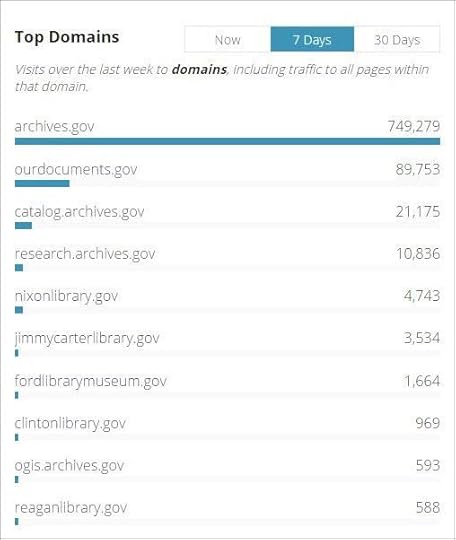
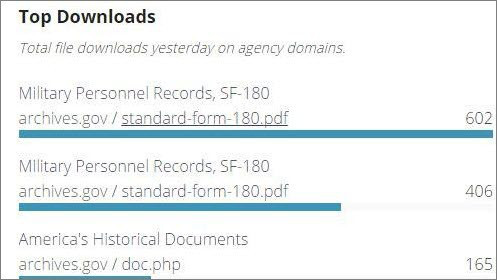 This application’s data helps us ensure that we design, maintain and update our websites to reflect the types of devices and browsers visitors use on our websites. We can also see what content the users are interested in. The analysis of data points such as these will help us effectively use our limited resources to best serve our customers.
This application’s data helps us ensure that we design, maintain and update our websites to reflect the types of devices and browsers visitors use on our websites. We can also see what content the users are interested in. The analysis of data points such as these will help us effectively use our limited resources to best serve our customers.
One of the pillars of Open Government is transparency. By working with other agencies to create and participate in projects such as this, NARA continues to open more access to our customers. This is just one more way that the National Archives is developing as an increasingly transparent, data-driven agency.
Learn more about the Digital Analytics Program from DigitalGov.

February 22, 2016
Why I Read
Having recently seen The Lady in the Van (three times!) I was reminded of how much I have enjoyed the work of Alan Bennett over the years—which led me to his Untold Stories, published in 2005. In a section on “Art, Architecture and Authors” he writes:
“Sometimes when one’s reading a book, a novel say, you come across a thought or a feeling, which you’ve had yourself, and, thinking it peculiar to yourself, you haven’t expressed or communicated it…and now here it is set down by someone else. And it’s as if a hand has come out and taken yours.”

Original Caption: The Librarian Carefully Enters the Consignment Into Her Books, 12/1952. Records of the U.S. Information Agency. National Archives Identifier 23932351
Doesn’t happen to me often, but often enough for Bennett’s words to strike home. I will sometimes be struck by a thought or use of language that makes me pause, reread, sometimes record, and always savor the moment. Why I read.

February 12, 2016
Celebrating Black History Month: Hidden Gems
Yesterday we talked about some major projects, supported by the National Historical Publications and Records Commission, documenting the contributions of African Americans to the American Story. While the history of Emancipation and the collected papers of Martin Luther King, Jr., are vital to understanding of our democracy, history, and culture, there are many other chapters:
The Oblate Sisters of Providence
The Oblate Sisters of Providence is the first successful Roman Catholic sisterhood in the world established by women of African descent. It was the work of a French-born Sulpician priest and four women, who were part of the Caribbean refugee colony which began arriving in Baltimore, Maryland in the late 18th century. The order founded the oldest continuously operating school for black Catholic children in the United States and is still educating children in Baltimore. A grant from the NHPRC helped the Oblate Sisters process and make available the historical photograph and scrapbook collection of approximately 16,000 photographs dating from the 1850s to 2003, including this touching image of orphans under their care.

Early 20th century photograph from the St. Frances Academy School, courtesy Oblate Sisters of Providence
Lena Horne
Lena Horne (1917–2010) was an American singer, dancer, actress, and civil rights activist. In a recording preserved by Pacifica Radio Archives with NHPRC support, Horne discusses her life and career, civil rights, Billie Holiday, Joe Lewis, Humphrey Bogart, and other people in her life. You can listen at https://soundcloud.com/pacificaradioarchives/lena-horne-1966-interview
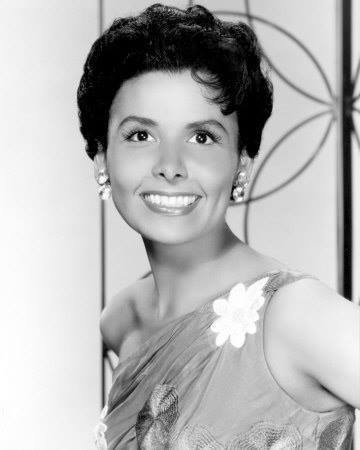
Lena Horne publicity photo, c. 1950s
The Auburn Avenue Researcher Libraries
The Auburn Avenue Researcher Libraries in Atlanta received funds from the NHPRC to digitize and make Web-accessible eleven late 19th and mid-20th century manuscript collections that document the historical development of education for African Americans, primarily in the South, from the early 1860s to the early 1950s. One collection is the archives of Annie L. McPheeters, one of the first African American professional librarians in the Atlanta Public Library and an influential proponent of African American culture and history. Educated at Clark University in Atlanta, she earned a degree in English, with a minor in education in 1929. During the early part of her career, she served as city and county librarian at the Greenville Public Library, where she drove the bookmobile throughout the county’s rural areas, seeing first-hand the desire of many African Americans to learn and have access to books. In 1934 she took a job at the Auburn Branch of the Atlanta Public Library as an assistant librarian. She set out to remedy the branch’s problems of low library use by developing several initiatives, including the Adult Education Project, and launched the Negro History Collection. Two years later, she was promoted to full librarian, becoming one of the first African American professional librarians in the Atlanta Public Library. Her papers are housed in the Archives Division of the Auburn Avenue Research Library.
Grace Marilynn James, M.D.
Grace Marilynn James, M.D., (1923-1989) spent her life caring for the African American community of Louisville, Kentucky, who often had little access to regular health care. She was the first African American woman on the staff of Louisville Children’s Hospital and on the faculty at the University of Louisville School of Medicine, and served as a role model and advocate for African Americans considering a career in medicine. The National Library of Medicine includes Dr. James in their special online exhibition “Changing the Face of Medicine: Celebrating America’s Women Physicians.” The University of Louisville holds Dr. James’s papers, and they were processed through a grant from the NHPRC. A finding aid is available through the Kentucky Digital Library.
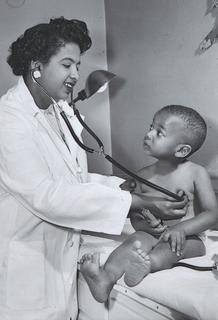
Dr. Grace M. James, c. 1953, with a young patient. Photo courtesy David James, National Library of Medicine
Thomas “Blind Tom” Wiggins
Thomas “Blind Tom” Wiggins (1849 – 1908) was an African-American musical prodigy. Born into slavery, he began composing music at age five, and he was hired out at the age of eight years to concert promoter Perry Oliver, who toured him extensively in the US, performing as often as four times a day. He was called the “human mockingbird” and was said to be able to reproduce songs after hearing them a single time. During the 19th century, he was one of the best-known American performing pianists, performing at the White House for President Buchanan in 1860. Geneva Handy Southall began researching “Blind Tom” during her Ph.D. studies, and she later wrote three books: Blind Tom: the Post-Civil War Enslavement of a Black Musical Genius (1979), The Continuing Enslavement of Blind Tom: the Black Pianist-Composer (1983), and Blind Tom, the Black Pianist Composer: Continually Enslaved (1999). She spent more than 30 years researching Blind Tom’s life and music and also made the first recording of his music. She was inducted into the Black Musicians Hall of Fame in 1988 and was a former board member of the National Association of Negro Musicians. The NHPRC funded the preservation of Dr. Southall’s papers at Emory University. A documentary on “Blind Tom,” with contributions by Dr. Southall, is online at http://vimeo.com/56242237
Arabella Chapman
One of our favorite collections was truly hidden. The Arabella Chapman Project is a great example of how archives connect with the classroom to harness the power of the crowd and make historical records vibrant. It all started with an NHPRC grant to the Clements Library at the University of Michigan to create finding aids for over 1,600 “hidden” collections. Among the records were photograph albums which had originally belonged to Arabella Chapman (1859-1927), an African American woman from Albany, New York. The albums were assembled from 1878 to 1900 using portraits taken from the 1860s to the turn of the century. The photos include Arabella, her family, friends, and admirers, and copies of pictures of well-known public figures–including Lincoln, Douglass, and others.

Arabella Chapman tintype, c. 1865. Clements Library, University of Michigan
During fall semester 2014, University of Michigan Professor Martha Jones’s African American Women’s History class embarked on a detailed examination of the albums to try to learn what they could about Arabella, her family and friends, and the role of photography in African American life in the late 19th century. Last spring, the students launched a website devoted to the Chapman albums. The Arabella Chapman Project includes scans of the album pages, genealogical information, maps, texts on the history of photograph albums, a portal for crowdsourcing more information, and more. They’ve published a series of questions and mysteries behind the images. And they’re using social media to reach out to a broader audience and to show how all black lives matter.
The Arabella Chapman Project is a fascinating approach to teaching history through historical records, and they are looking for your help. Recognize someone? Know something? Join the crowd in adding more layers to this piece of the American Story.

February 11, 2016
Celebrating Black History Month
Every day, we celebrate the remarkable contributions of African Americans to the American Story. The National Archives contains millions of records related to the interactions of African Americans with the Federal government—from the Emancipation Proclamation to the millions of historical records ranging from the Census to military service.
The National Archives grant program, our National Historical Publications and Records Commission, extends the reach of the agency and connects to thousands of collections across the country at state and local governments, colleges and universities, historical societies, and other nonprofit organizations. Over the past 50 years, the NHPRC has awarded grants to projects to document black lives.
Among the earliest records are those dealing with slavery and the fight for freedom. The Frederick Douglass Papers, the Black Abolitionist Papers, the Race and Slavery Petitions project at the Digital Library on American Slavery, Freedmen and Southern Society, and the O.O. Howard (head of the Freedman’s Bureau and founder of Howard University) projects were all supported with major funding from the NHPRC, and other grants went to the preservation of court and chancery records which deal with landmark events such as the Dred Scott case at the Supreme Court of Missouri and manumission petitions now being digitized by the Maryland State Archives.
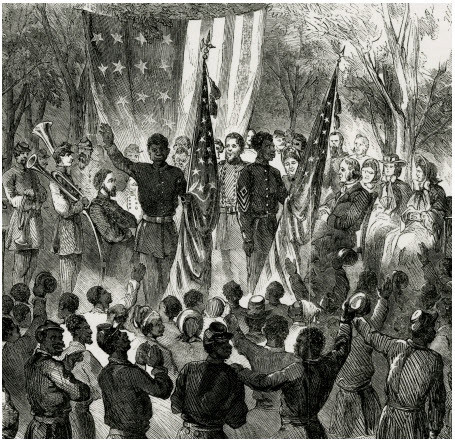 Freedman and Southern Society Project
Freedman and Southern Society Project
Following emancipation, the quest for equal rights is documented in the early 20th century records such as Booker T. Washington Papers and a microfilm edition of the W.E.B. Dubois Papers to the latter decades with the papers of such civil rights leaders as Clarence Mitchell, Ted Berry, the archives of Mary McLeod Bethune and the National Council of Negro Women, and the Papers of Martin Luther King, Jr. Archives from the history of Boston Desegregation (some of which are now part of the National Archives DocsTeach site) to the preservation of film interviews from the landmark PBS series “Eyes on the Prize” are but some of the many collections of interest for students of American civil rights history.
Tomorrow, we’ll look at some “hidden” gems.

February 9, 2016
Remembering Robin Chandler Duke
As the University Librarian at Duke one of my favorite duties was talking people into donating their personal collections to the University Library. My staff had great intelligence about who we should go after to strengthen the collections, so I was always armed with rationale(s) for the fit at Duke.
The passing of Robin Chandler Duke on Saturday reminded of those encounters with donors. Robin was the widow of Angier Biddle Duke, Chief of Protocol in the Kennedy White House and Ambassador to El Salvador, Spain, Denmark, and Morocco from the Truman through the Johnson Administrations. And one of THE DUKES—the family of the founder of the university.

President of India, Dr. Sarvepalli Radhakrishnan, shakes hands with First Lady Jacqueline Kennedy upon his departure from the White House, following a state dinner in his honor; President John F. Kennedy stands at center left. US Chief of Protocol, Angier Biddle Duke, stands at right (back to camera); Robin Chandler Duke (wife of Ambassador Duke) stands at far left. North Portico, White House, Washington, D.C. June 3, 1963.
Robert Knudsen. White House Photographs. John F. Kennedy Presidential Library and Museum, Boston. National Archives and Records Administration
We already had the Ambassador’s personal papers in our holdings, so Robin’s were a logical quest.
I remember my first visit to her apartment at River House in New York City, sitting in her sunroom overlooking the East River. Grace, beauty, charm, wit, and intelligence are my memories of that first encounter. She assumed, I think, that I was most interested in whatever of the Ambassador’s papers she still had, and was surprised about how much I knew about her own career.
Robin was a newspaper and television journalist, vice president for public relations at Pepsi-Cola, active in organizations supporting abortion rights and legal equality for women. The best part of that first visit was seeing evidence of “documentation.” She saved everything! And her life and letters complemented her husband’s ambassadorial life, contributed to the burgeoning women’s studies collection, and her Pepsi years added to the strength of the one of the best advertising collections in the country.
That first visit led to a deed of gift and the beginning of a relationship that was punctuated by regular deliveries of boxes of her papers and photographs as she continued to sort through her collection. Whenever I was in New York, I would stop for a quick visit to catch up. And when I made the move to the New York Public Library, she was among the special guests invited to a reception hosted by another “Dukie,” Ellie Elliot.
A while ago I wrote about my afternoon with Lauren Bacall and now Robin Chandler Duke. One lucky guy to have spent time with two extraordinary women!

David S. Ferriero's Blog


